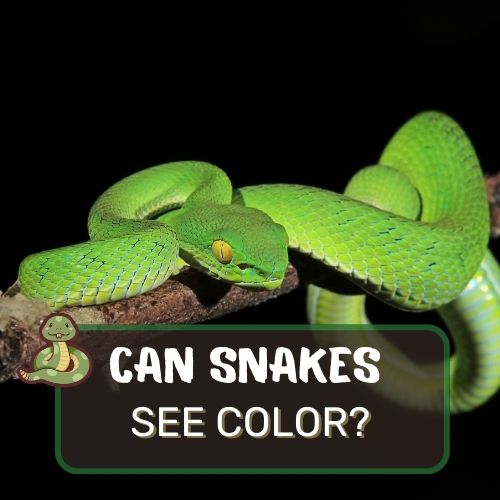
Exploring the captivating question, “Can snakes see color?“, this article delves into the intriguing world of snake vision.
Unveiling the unique mechanisms that shape their perception, we’ll uncover the role of dichromatic vision and UV sensitivity in their color experience.
From their specialized retinas and cones to their ability to detect subtle patterns, we’ll journey through how snakes navigate the spectrum of color.
Join us as we decipher how snake vision differs from human perception, unravel the significance of UV sensitivity, and shed light on their color perception in low light conditions.
This exploration promises a deeper understanding of the mesmerizing adaptations that shape snakes’ relationship with the colorful world around them.
Table of Contents
- 1 Can snakes see color? (Summary)
- 2 The Enigmatic World of Snake Vision
- 3 The Research on Snake Color Vision
- 4 Snake Color Perception
- 5 Snake Color Vision Range
- 6 UV Sensitivity in Snakes
- 7 Snake Vision vs. Human Vision
- 8 Snake Vision in Low Light Conditions
- 9 Snake Perception of Red Color
- 10 Evolutionary Adaptation of Snake Vision
- 11 FAQ
- 12 Reflecting on Snakes’ Color Perception
Can snakes see color? (Summary)
Yes, snakes can see color, but their perception of color differs from that of humans. Most snakes possess dichromatic vision, meaning they have two types of color-sensitive cone cells compared to humans’ three. This adaptation limits the range of colors they can perceive. Snakes are sensitive to blue and green wavelengths of light and might struggle to distinguish reds and other longer wavelengths. Additionally, their ability to perceive ultraviolet (UV) light adds another dimension to their color perception, allowing them to detect patterns and cues invisible to humans.
The Enigmatic World of Snake Vision

Snake Vision Mechanisms
Although not their primary sense, snakes possess an intricate visual system that grants them insights into their environment in ways we might not expect.
Snake vision is a complex adaptation that varies across species, enabling them to thrive in diverse environments:
- Rod and Cone Cells: Like other vertebrates, snakes have rods (for low-light vision) and cones (for daytime and color vision). However, many species are more rod-dominant, aiding in nocturnal activity.
- Pit Organs: Some snakes, especially vipers, pythons, and boas, possess specialized pit organs that detect infrared radiation, allowing them to “see” the body heat of prey, which is invaluable for hunting in darkness.
- Spectacle: Snakes don’t have eyelids. Instead, they have a transparent scale, called a spectacle, protecting their eyes.
- UV Vision: Some snake species can detect ultraviolet light, enhancing their ability to locate prey or mates.
- Parietal Eye: Certain snakes have a light-sensitive “third eye” on top of their head, which aids in regulating circadian rhythms.
These mechanisms collectively enhance a snake’s visual prowess, ensuring they can effectively hunt, navigate, and communicate in their respective habitats.
The Distinctive Retinas and Cones of Snakes
The retinas of snakes are specialized structures that play a crucial role in their vision. Here’s a closer look at their retinas and cones:
- Retinal Composition: A snake’s retina contains both rod and cone cells. Rods are responsible for low-light or nocturnal vision, while cones manage color and daylight vision.
- Cone Diversity: Snakes have a varying number of cone types. Some species possess multiple cone types, allowing them to discern a range of colors, while others might be more limited.
The Research on Snake Color Vision

Delving into Snake Color Perception
Scientific inquiry has led to comprehensive studies aimed at unraveling the intricacies of snake vision.
These investigations venture into the depths of snake retinas and neural pathways, aiming to unravel the mechanisms that govern their distinct color perception.
The Spectrum of Snake Vision
The outcomes of these studies are captivating. Unlike humans, who revel in a spectrum of colors, snakes live in a world defined by a limited palette.
Their visual universe is dominated by blue and green wavelengths, influencing how they navigate and engage with their surroundings.
Implications of Snake Vision
The concept of dichromatic vision sparks discussions about the evolutionary marvels of snakes.
Thriving in habitats often dominated by shades of green and blue, their specialized vision is a testament to their adaptability.
This intriguing adaptation may hold the key to their survival strategies.
Snake Color Perception
A Unique View of Colors
The world of snake color perception is a realm of wonder that diverges from our own experience. Snakes perceive colors differently from humans due to their dichromatic vision.
While humans possess three types of color receptors, enabling us to distinguish a broad spectrum of colors, snakes rely on just two. This difference shapes how they interpret the world around them.
Factors Shaping Snake Color Perception
Several factors contribute to the distinct color perception of snakes. Their natural habitats play a crucial role.
Snakes inhabit environments where colors like green and blue predominate, making their vision well-suited to discerning these hues.
Additionally, the types of prey they hunt and their need for camouflage influence how their visual system has evolved.
Snake Color Vision Range

Exploring the Color Spectrum
While snakes possess a more limited color perception compared to humans, they still have a unique range of colors they can see. Their dichromatic vision primarily allows them to perceive colors in the blue and green spectrum.
This ability aligns with their natural surroundings, enabling them to differentiate between various shades of foliage and potential prey.
Limits to Snake Color Vision
Despite their specialized color perception, snakes have limitations when it comes to colors. They struggle to perceive reds and oranges, as their vision is not optimized for these wavelengths.
This limitation stems from their reliance on blue and green cones, which are less sensitive to longer wavelengths of light.
Therefore, their visual experience is skewed towards cooler tones, with warmer colors being less distinguishable.
As we delve deeper into the intricacies of snake color vision, we gain a profound understanding of how diverse life forms adapt to their environments.
The world seen through a snake’s eyes is a unique landscape of blues and greens, each shade holding its own significance in their survival strategies.
By examining the nuances of their visual system, we gain insight into the interconnectedness of life, where every species perceives and interacts with the world in its distinct way.
UV Sensitivity in Snakes

Unveiling Snake UV Sensitivity
Beyond the dichromatic vision and unique color perception, snakes possess another remarkable attribute: sensitivity to ultraviolet (UV) light.
While humans cannot perceive UV light, snakes have specialized adaptations that enable them to do so.
UV sensitivity adds another layer to their perception of the world.
The Significance of UV Sensitivity
UV sensitivity holds great importance for snake vision, particularly in their natural habitats. UV light reveals details that are invisible to humans.
Snakes can detect UV patterns on prey items, foliage, and even the skin of other snakes.
These patterns provide them with crucial information about their environment, interactions, and potential threats.
UV Sensitivity’s Role in Hunting and Survival
The ability to detect UV patterns offers snakes a unique advantage in their hunting and survival strategies.
When stalking prey, they can perceive subtle changes in UV reflectance, helping them identify concealed prey or distinguish between different species.
Additionally, UV patterns on their own bodies play a role in communication and mate selection, allowing them to convey information invisible to the human eye.
Snake Vision vs. Human Vision

Contrasting the Worlds of Snake and Human Vision
Comparing snake vision to human vision unveils the intricate tapestry of sensory experiences. While humans perceive the world in a broad spectrum of colors, snakes perceive a more limited palette dominated by blue and green.
This difference stems from their dichromatic vision, which influences how they interpret their surroundings.
Decoding the Color Perception Divide
The divergence in color perception between snakes and humans is not a mere quirk of biology. It is a consequence of adaptation to different ecological niches.
Snakes, often residing in environments where shades of green and blue predominate, have honed their vision to detect nuances crucial for survival in these settings. In contrast, human color vision is tailored to the diverse landscapes we inhabit.
Snake Vision in Low Light Conditions

Unveiling Nocturnal Prowess
Snakes, often regarded as creatures of the night, possess a remarkable ability to navigate and perceive their surroundings in low light conditions.
While humans may struggle in such environments, snakes shine. Their visual system has evolved to excel in dim light, making them adept nocturnal hunters.
Illuminating the Role of UV Sensitivity
The ability to perceive ultraviolet (UV) light extends its influence to low light scenarios as well. In dimly lit landscapes, UV patterns on prey, foliage, and other elements become more pronounced.
Snakes can leverage these patterns to identify potential food sources, assess their environment, and even detect predators that might otherwise remain concealed.
Snake Perception of Red Color

The Intriguing Riddle of Red
While snakes possess a unique color perception, the perception of red poses a particular puzzle. Generally, snakes struggle to perceive red colors as vibrantly as humans do.
Due to their dichromatic vision and the absence of specialized receptors for longer wavelengths, reds may appear dull or even blend into the background.
Comparing Snake and Human Red Perception
In the realm of red, the contrast between snake and human vision is stark. Humans, with their trichromatic vision, relish a broad spectrum of reds. For snakes, reds might be perceived as shades of brown or even black, depending on the specific species.
This disparity in red color perception underscores how each species’ visual system is attuned to its unique ecological context.
As we journey through the multifaceted world of snake vision, we uncover layers of complexity that reflect the intricacies of nature’s design.
From their prowess in low light conditions to the enigma of red perception, each aspect of snake vision unveils adaptations sculpted by evolution.
By dissecting these nuances, we gain a profound appreciation for the diversity of life forms and their exceptional strategies for thriving in diverse environments.
Evolutionary Adaptation of Snake Vision

The Dynamic Evolution of Snake Vision
The evolution of snake vision offers a captivating glimpse into how these creatures adapted to diverse habitats and lifestyles:
- Ancestral Origins: Early snakes, evolving from burrowing ancestors, likely had limited vision due to subterranean habitats. This is reflected in some modern burrowing snakes with reduced eyes.
- Rod Dominance: As many snake species adopted nocturnal lifestyles, their retinas became rod-dominant, enhancing low-light vision.
- UV and Infrared Detection: Some snakes evolved the ability to detect ultraviolet light or infrared radiation, aiding in prey detection.
- Loss of Color Vision: While ancestral reptiles had color vision, many snake species lost certain cone types, resulting in dichromatic vision.
- Pit Organs: Vipers, pythons, and boas evolved specialized pit organs, detecting infrared heat from warm-blooded prey, a significant adaptation for nocturnal hunting.
The evolutionary trajectory of snake vision underscores their adaptability, with each modification serving specific ecological and survival needs.
Strategies for Survival: Hunting, Camouflage, and Beyond
Snake vision’s evolution is intertwined with strategies for survival. Their unique color perception aids in blending into surroundings, offering camouflage from predators and allowing them to ambush prey.
The ability to perceive UV light and see well in low light conditions enhances their hunting prowess. This visual toolkit equips them to thrive in environments where color patterns and visual cues hold paramount importance.
FAQ
How do snakes see humans?
Snakes perceive humans through their visual system, although the exact experience may differ from how humans perceive each other. Snakes’ dichromatic vision means that their perception of humans might be limited to shades of blue and green, along with UV patterns on our skin or clothing.
Can snakes see black?
While snakes can perceive a range of colors, their vision is adapted for specific wavelengths. They might not perceive black in the same way humans do. Instead, darker colors might appear as shades of gray or brown.
Do snakes have good eyesight?
Snakes’ eyesight is adapted to their ecological needs. While they might not possess the intricate color spectrum and visual acuity of humans, their vision is finely tuned for detecting movement, assessing their environment, and capturing prey.
Can snakes see red light?
Snakes’ dichromatic vision makes it challenging for them to perceive red as vividly as humans. Red light might appear as a shade of brown or gray to them due to their limited receptors for longer wavelengths.
What colors do snakes see best?
Snakes are most sensitive to blue and green wavelengths of light. These colors are likely more distinct to them due to their visual system’s adaptations. Their ability to perceive UV light further enriches their perception of their surroundings.
Reflecting on Snakes’ Color Perception
The journey into the world of snake vision has illuminated the intricate mechanisms that shape how these creatures perceive color. From their unique dichromatic vision to the addition of UV sensitivity, each facet of snake vision reflects their evolutionary journey and ecological adaptations.
Snakes’ ability to see color, though different from our own, is a testament to the diversity of life on Earth.
Their visual system, finely tuned for survival in their environments, underscores the remarkable ways in which different species have evolved to thrive in their unique niches.
The intricate interplay between their vision and their surroundings adds another layer to our understanding of the beauty and complexity of the natural world.
As we conclude this exploration of snake color vision, we are reminded that every species has its own lens through which it perceives the world, contributing to the rich tapestry of life’s adaptations and interactions.




0 Comments